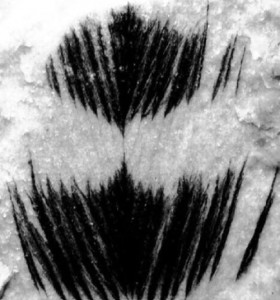
After a recent discovery, scientists are beginning to rethink their images of the prehistoric world. Thanks to preserved evidence of melanin in a fossil feather from Brazil, paleontologists at the Peabody Museum have come one step closer to reconstructing a visual representation of early birds and dinosaurs.
Until recently, there were frustratingly few ways to determine the presence of skin, fur, and feathers from the fossil record. Paleontologists had assumed the ovoid structures found in fossilized feathers and retinas were impressions left by bacteria that consumed the keratin of these structures.
Similarly, they had hypothesized that the dark spots often observed in fossils were carbonaceous remnants of the bacteria’s bodies rather than of elements produced by the bird or dinosaur itself.
However, in 2006, Geology and Geophysics graduate student Jakob Vinther noticed that the fossilized ink sacs of a completely different specimen, squid, contained melanin preserved as large macromolecules. As such, he postulated that some form of the pigment could be found in melanin-containing structures of other organisms—even distantly related animals like birds and dinosaurs.
Vinther, along with professor Derek Briggs of the Geology Department, feather specialist Rick Prum of the Ecology and Evolutionary Biology Department, and ornithology Ph.D student Vinodkumar Saranathan, examined a color-banded feather to see if this was the case.
Using a scanning electron microscope (SEM) and energy dispersive X-ray analysis, they set out to evaluate whether the observed 1-2μm structures were bacterial impressions or traces of the original feather pigmentation.
In colored feathers, the melanin-containing organelles (called melanosomes) are organized along the planes of the feather’s barbs and barbules; they are absent in white areas of the feather. After examining the fossil feather from Brazil and comparing it to feathers from a Red Winged Blackbird, the researchers discovered that the banded areas of the fossil feather showed evidence of melanin preservation in places consistent with those of modern birds.
The areas of the fossil with carbon residue also had ovoid impressions and thus melanosomes. Meanwhile, uncolored areas of the feather were free of both the ovoid impressions and the carbonaceous residues, meaning that the preserved ovoid shapes were not the bodies of bacteria but impressions of the actual specimen’s melanosomes.
The areas with carbon-residue showed that the impressions were organized identically to banding patterns seen in existant birds and would have been consistent with modern growth and coloration mechanisms in feather development. The researchers also examined fossil retinas and found evidence of retinal pigments.
This method can reveal red-yellow (phaeomelanin) and black pigments (eumelanin), and if the melanosomes are coherently organized, provide clues about whether an area of the feather could have been iridescent. More subtle color variations would require the preservation of carotenoid pigments (which produce yellow, orange, and bright-red) or air bubbles in the keratin of the feather matrix (which produces blues and greens).
While scientists cannot yet pull all the colors of ancient birds from the stones just yet, this discovery is a significant step in that direction, and gives us a better means for predicting the camouflage and mating signals of some of earth’s most majestic creatures.
